The Blue-ringed octopus is one of the ocean’s most enigmatic creatures. Known for its stunning beauty and deadly venom, this tiny titan of the deep has fascinated marine enthusiasts and scientists alike.
So, whether you’re a seasoned diver, a marine biology nerd, or just someone who loves a good creature feature, buckle up. We’re about to get up close and personal with an animal that packs a serious punch in a pint-sized package.
What is the Blue-ringed Octopus?
The Blue-ringed octopus isn’t just any sea creature; it’s the ocean’s compact assassin, cloaked in an aura of mystery and danger. Belonging to the genus Hapalochlaena, these venomous marine animals are more than just pretty faces with hypnotic blue rings. They’re one of the most fascinating species to grace the underwater world, combining lethal power with an undeniable allure.
Despite their small size, they carry one of the most potent venoms found in nature. But don’t let their diminutive stature fool you. These creatures are as intriguing as they are deadly, playing a crucial role in the marine biodiversity puzzle. They remind us of the ocean’s vast mysteries and the delicate balance of life beneath the waves.
What does the Blue-ringed Octopus Look Like?
Imagine the perfect blend of mystery, danger, and beauty. That’s the Blue-ringed octopus for you. Typically, these creatures boast a soft, squishable body that can squeeze into the tiniest of crevices. Their skin is smooth, almost velvety to the touch – if you ever got close enough to touch one, which, by the way, is not recommended.
The real show-stopper, though, is their vibrant blue rings. Against a backdrop of yellowish to brown skin, these electric-blue rings light up like neon signs when the octopus feels threatened or is about to attack. It’s a mesmerizing display, a warning sign of the potent venom that lies within. But when they’re chilling out, not feeling threatened or anything, those rings blend into their body, making them masters of camouflage.
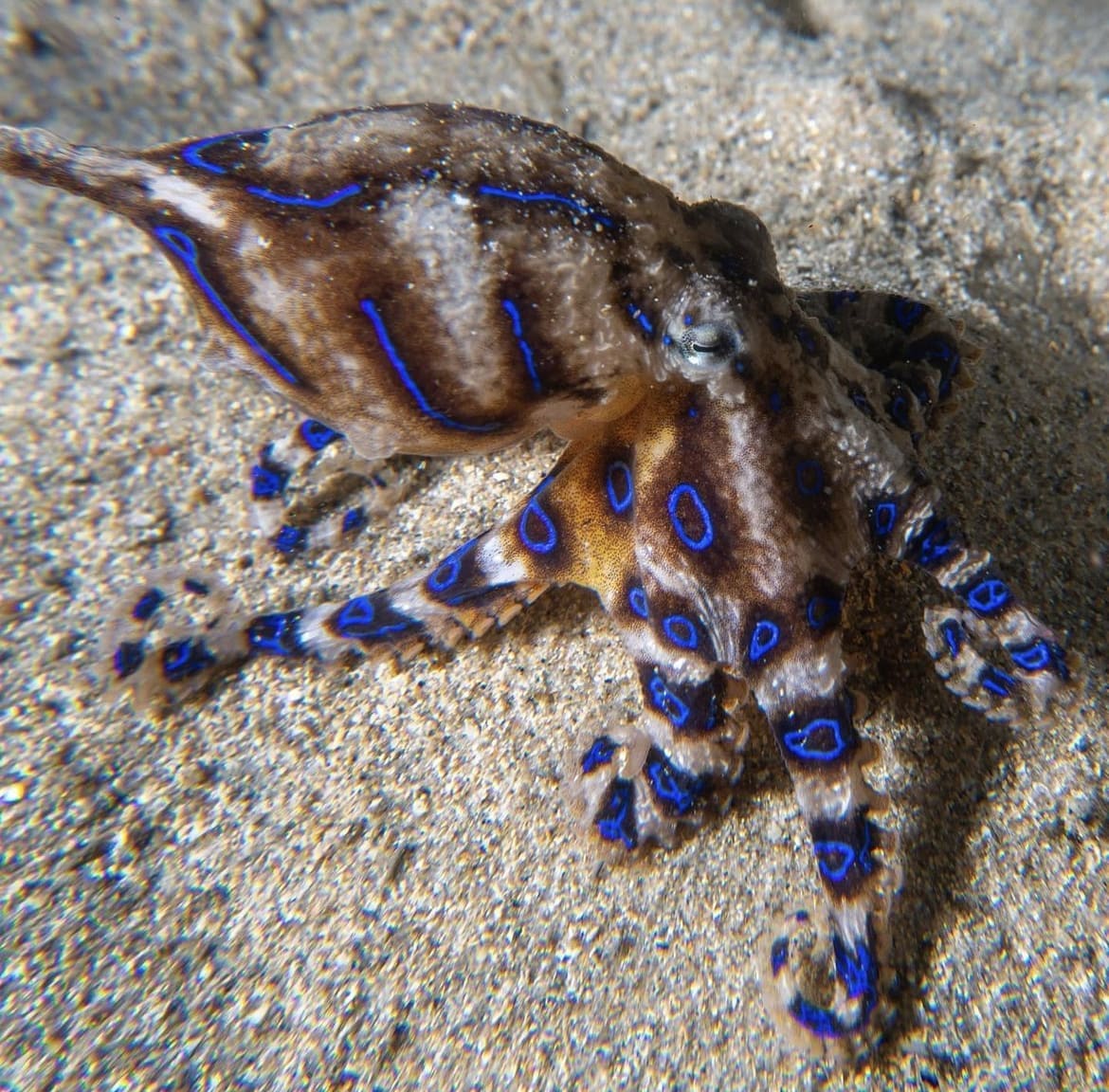
How Big are Blue-ringed Octopuses?
Now, you might be thinking, “With all this talk of venom and vibrant rings, these octopuses must be huge, right?” Well, not exactly. Blue-ringed octopuses are surprisingly small, often fitting in the palm of your hand. They typically grow to about 5 to 8 inches in length – that’s including their arms. Yeah, they’re small, but remember, in the ocean, size isn’t everything. These little guys pack enough venom to take down predators (or prey) much larger than themselves.
Their size makes them even more fascinating because it’s a stark reminder of how something so small can have such a significant impact. It’s like nature’s way of saying, “Don’t underestimate the little guy.” Plus, their compact size allows them to navigate the nooks and crannies of coral reefs and rock pools, making them elusive masters of hide and seek.
Blue-ringed Octopus Skin
When it comes to the Blue-ringed octopus, its skin is not just a pretty cover; it’s a sophisticated tool that helps it survive and thrive in the wild. This isn’t your average, garden-variety skin we’re talking about. It’s a dynamic canvas that changes texture and color, allowing the octopus to blend seamlessly into its surroundings. Think of it as the ultimate underwater camouflage gear.
But here’s the kicker: when threatened, their skin becomes the stage for a dazzling display of vivid blue rings, a stark warning to anyone who dares get too close. This sudden shift from stealth mode to flashing warning signs is all thanks to special cells in their skin called chromatophores. It’s like having mood rings all over your body, but instead of showing your mood, they say, “Back off, buddy!”
Blue-ringed Octopus Tentacles
Ah, the tentacles. No discussion about octopuses would be complete without talking about these versatile limbs. Blue-ringed octopus tentacles are like Swiss Army knives, equipped for just about anything. Each of their eight arms is dotted with suction cups that are not only perfect for gripping onto surfaces but also for exploring their environment and, most importantly, catching dinner.
What’s fascinating is the precision and control these creatures have over their tentacles. Whether it’s delicately picking apart a small crab or jetting away from danger, their tentacles are up to the task. And while they might not look like much, these limbs are incredibly strong for their size. So, whether it’s foraging for food or warding off predators, those tentacles are pivotal to the survival of the Blue-ringed octopus in the wild.
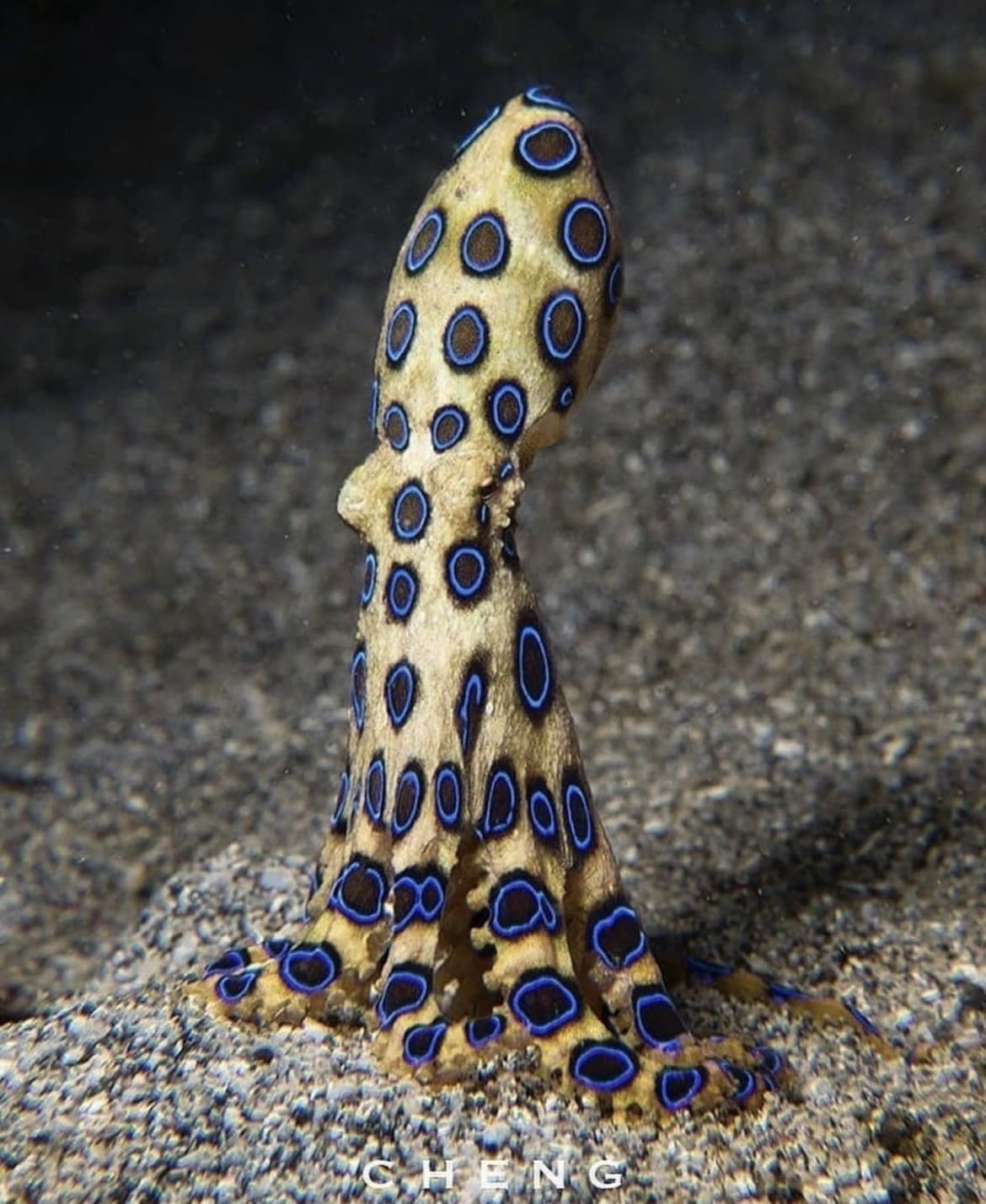
Blue-ringed Octopus Colouration
The coloration of the Blue-ringed octopus is nothing short of a masterpiece. Typically, their body sports a mottled pattern of yellows, browns, and oranges, perfectly suited for blending into the sandy or rocky ocean floor. But those blue rings? They’re the octopus’s ace in the hole.
Activated in moments of danger or aggression, these rings serve as a potent visual deterrent, signaling to potential threats that it’s in their best interest to steer clear. The intensity and brightness of the blue can vary, seemingly in tune with the octopus’s mood and the level of threat it perceives. It’s a brilliant example of how coloration in the animal kingdom can be used for communication, camouflage, and caution all at once.
What does the Blue-ringed Octopus Eat?
Blue-ringed octopuses have a diet that’s as interesting as their appearance. These creatures are cunning hunters, primarily feasting on small crabs, shrimp, and occasionally fish. Their hunting strategy? A mix of stealth, speed, and that infamous venom. They use their camouflage to sneak up on unsuspecting prey, then pounce, using their tentacles to grasp and paralyze their meal with venom before enjoying their catch.
This method of hunting not only showcases their predatory skills but also emphasizes their role in the marine ecosystem as controllers of the crustacean population. So, the next time you’re enjoying a peaceful snorkel, remember that beneath you, there might just be a Blue-ringed octopus on the hunt, maintaining the balance of ocean life one bite at a time.
Blue-ringed Octopus Social Structure
These creatures are the epitome of introverts, preferring a solitary existence. You won’t find them forming colonies or hanging out in groups. Instead, they stake out a lair (often in crevices or under rocks) and spend most of their time alone, venturing out mainly to hunt or mate.
This preference for solitude means that encounters between Blue-ringed octopuses are rare and usually brief unless it’s mating season. It’s a lifestyle that suits their needs, minimizing competition and the risk of predation. In the vast and bustling cities of the sea, the Blue-ringed octopus is the solitary wanderer, content in its own company.
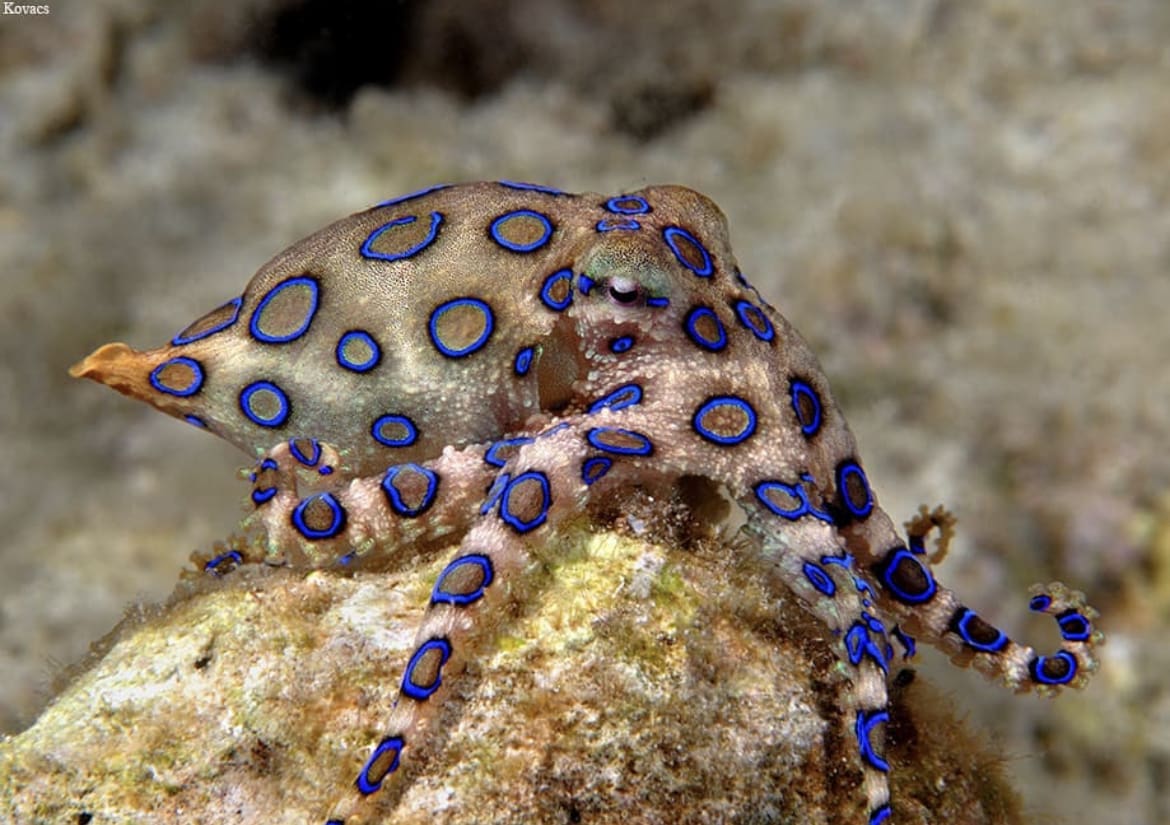
How do Blue-ringed Octopus Reproduce?
The reproductive strategy of the Blue-ringed octopus reads a bit like a tragic romance. Mating is a rare event in the life of these solitary creatures. When they do find each other, the male uses a specialized arm to transfer sperm packets directly into the female’s mantle cavity, a process devoid of any courtship rituals that are common in other marine species.
After mating, the female lays her eggs, which she meticulously cares for, cleaning and guarding them until they hatch. This period marks a significant shift in her life, as she stops eating and dedicates herself entirely to the protection of her future offspring. Once the eggs hatch, the cycle of solitude begins anew for the young octopuses, and the mother’s mission is complete, often culminating in her death.
How Long do Blue-ringed Octopus Live?
The life of a Blue-ringed octopus, while intense and filled with drama, is relatively short-lived. These creatures have a lifespan of approximately two years. Yes, that’s right. In just a couple of years, they experience the full cycle of life – from hatching to growing, maturing, and if they’re lucky, reproducing. This brief existence is a common trait among cephalopods, living their lives in a fast-paced blur of feeding, hiding, and, for some, a single chance at parenthood.
This fleeting lifespan puts into perspective the urgency of their life events, including their growth, hunting skills development, and reproductive efforts. Every moment counts in the life of a Blue-ringed octopus, making their existence all the more remarkable and precious.
Are Blue-ringed Octopus Aggressive?
Given their deadly venom, it’s easy to assume that Blue-ringed octopuses might be the bullies of the sea. However, this couldn’t be further from the truth. These octopuses are, by nature, shy and elusive creatures. They prefer to avoid confrontation and will only display their iconic blue rings or resort to biting as a last resort when they feel threatened or cornered.
Their primary defense mechanism is their ability to blend into their surroundings, hiding away from potential threats rather than confronting them. So, while they possess a powerful form of protection in their venom, Blue-ringed octopuses are far from being the aggressors of the ocean. Instead, they embody the “speak softly and carry a big stick” approach to dealing with dangers in their environment.
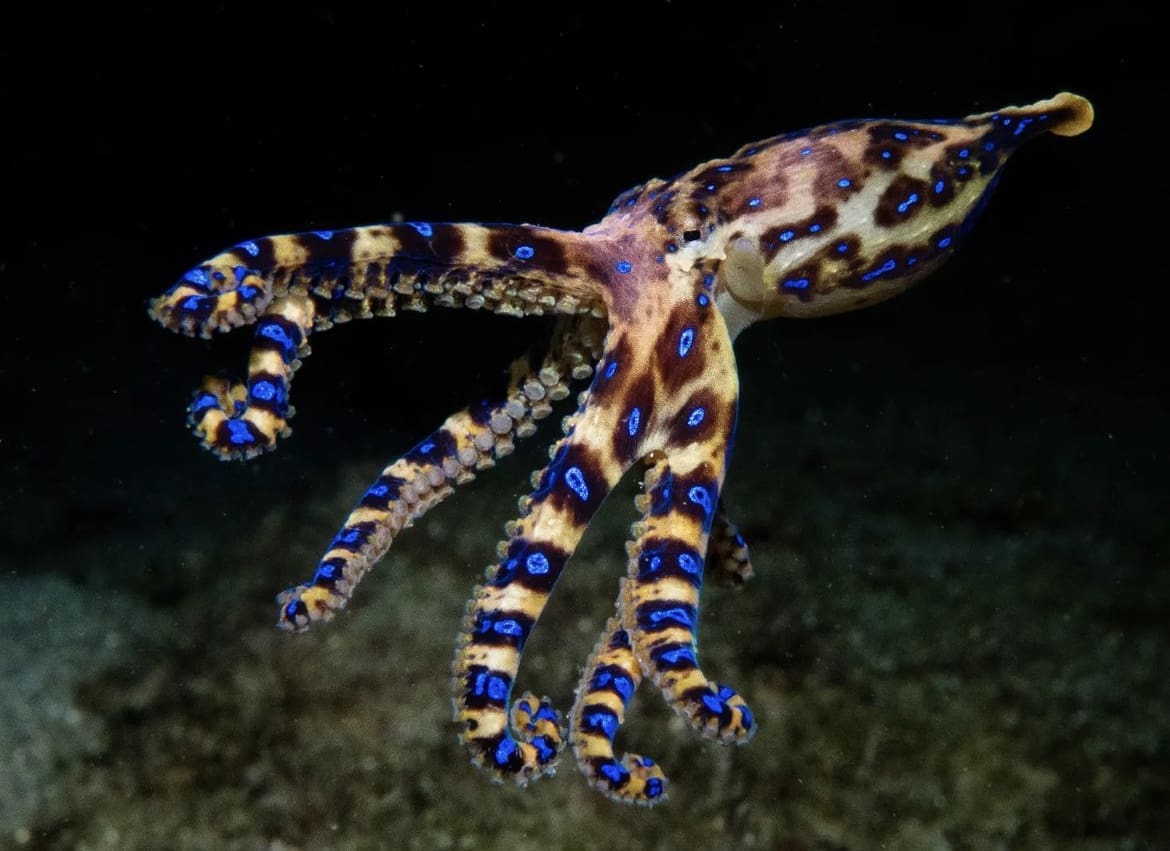
Is the Blue-ringed Octopus Territorial?
When it comes to their living space, Blue-ringed octopuses exhibit a preference for solitude but are not particularly territorial in the aggressive sense. They seek out and establish dens in crevices, shells, or under rocks on the ocean floor, which serve as their home base. While they might defend their immediate dwelling if disturbed, they do not patrol or aggressively guard a defined territory.
Their solitary nature means interactions with other Blue-ringed octopuses are minimal outside of mating. This lack of territorial aggression allows them to coexist relatively peacefully with other marine life, as long as their personal space in their chosen hideout is respected. It’s a delicate balance of live and let live, underpinned by a mutual understanding and respect among the ocean’s inhabitants.
How Fast are Blue-ringed Octopus?
When it comes to speed, Blue-ringed octopuses may not be the sprinters of the sea, but they’re certainly not sluggish. Their movement is graceful and calculated, using a combination of crawling with their tentacles and jet propulsion. This jet propulsion, a common mode of transport among cephalopods, allows them to quickly escape predators by expelling water through a funnel, propelling them backward.
While they can make a quick getaway when threatened, they prefer a stealthy approach to hunting and exploring their environment. Their speed is sufficient for their needs, striking a balance between the energy conservation required for their solitary lifestyle and the bursts of speed necessary for evasion or hunting.
Blue-ringed Octopus Venom
The venom of the Blue-ringed octopus is where beauty meets danger in a profound way. This venom, containing the powerful neurotoxin tetrodotoxin, is capable of paralyzing and killing prey and potential threats, including humans. What makes this venom particularly intriguing (and terrifying) is its efficiency; there is currently no known antivenom.
Tetrodotoxin blocks sodium channels, preventing nerve signals from getting through, leading to muscle paralysis and, in severe cases, respiratory failure. However, the octopus uses this potent weapon judiciously, primarily for hunting and self-defense. The venom is delivered through a bite, which can be almost imperceptible, making awareness and caution essential when in areas where these octopuses are known to live.
@rowy_finds_sea_treasures
Where do Blue-ringed Octopus Live?
The Blue-ringed octopus is a testament to the diversity and adaptability of marine life, thriving in a variety of oceanic habitats. They are predominantly found in the Pacific and Indian Oceans, from Japan down to Australia. Their preferred environments include tidal pools, coral reefs, and under oceanic debris, where they can find ample hiding spots and hunting grounds.
These octopuses favor shallow waters, which offer a rich biodiversity of potential prey and protection against larger predators. Their choice of habitat also makes them accessible to curious humans, underscoring the importance of respect and caution when exploring these environments. The beauty and allure of the Blue-ringed octopus’s home are matched by the dangers it presents, serving as a reminder of the respect the ocean demands from those who venture into its depths.
How Many Blue-ringed Octopus are there in the Wild?
Quantifying the exact number of Blue-ringed octopuses in the wild is a challenging task, primarily due to their elusive nature and the vast expanses of their habitats. There are no precise population counts available, but they are considered to be relatively common within their geographical range. However, common doesn’t mean invulnerable. The health of their populations is closely tied to the health of the marine environment, making them indicators of oceanic well-being.
Researchers and conservationists monitor their presence as part of larger marine biodiversity studies, aiming to ensure that these fascinating creatures, along with their ecosystems, remain robust and resilient. Their numbers in the wild serve as a subtle reminder of the delicate balance within marine ecosystems and the importance of every species within it.
Are Blue-ringed Octopus Endangered?
Currently, the Blue-ringed octopus is not listed as endangered. However, like many marine species, they face threats from habitat loss, pollution, and the impacts of climate change. Their reliance on coral reefs and tidal pools makes them particularly vulnerable to the degradation of these environments.
Conservation efforts aimed at preserving marine biodiversity indirectly benefit the Blue-ringed octopus by maintaining healthy habitats for them and countless other species. The absence of an endangered status does not mean they are without risk, emphasizing the need for ongoing conservation initiatives to protect our oceans’ complex and interconnected ecosystems.
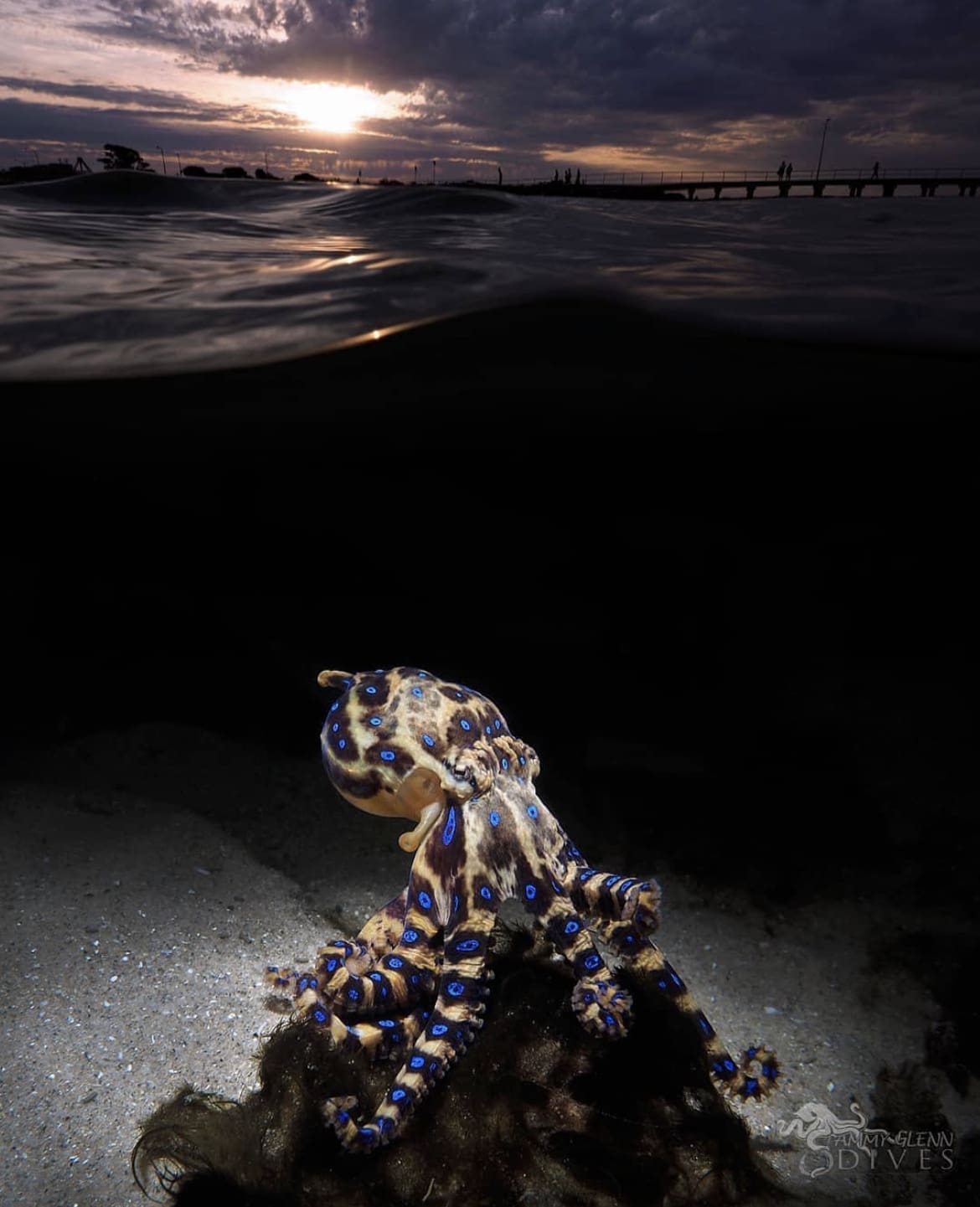
Threats to the Blue-ringed Octopus in the Wild
The Blue-ringed octopus, despite its venomous defense mechanism, faces several threats in the wild. Habitat destruction is a significant concern, with coastal development, pollution, and destructive fishing practices diminishing the quality and availability of their natural habitats. Coral reef degradation, a crucial component of their environment, poses a severe threat due to climate change, ocean acidification, and other human-induced factors.
Additionally, their distinctive appearance and intriguing nature make them targets for the exotic pet trade, which can lead to overcollection in some areas. While they are not typically consumed by humans, bycatch in fishing operations can also impact their populations.
The survival of the Blue-ringed octopus, and indeed all marine life, is tightly interwoven with the health of marine ecosystems. The threats they face underscore the urgency of marine conservation efforts, aiming to safeguard the oceans and the myriad of life forms they harbor.
Where to see Blue-ringed Octopus in the Ocean
The Blue-ringed octopus can be found in the warm, tropical waters of the Pacific and Indian Oceans, with a range that spans from the southern coasts of Japan, through the Philippines and Indonesia, down to the northern shores of Australia. Renowned for their preference for shallow waters, these octopuses are often encountered in coral reefs, rock pools, and under oceanic debris along the coast.
For those keen on spotting these marvels while diving or snorkeling, locations like the Great Barrier Reef in Australia, the coastal waters around Japan, and various dive sites in Indonesia offer the best chances. However, it’s essential to prioritize safety and respect for their natural environment. Disturbing their habitats or attempting to handle them can be dangerous and detrimental to their well-being.
Tips for Spotting Blue-ringed Octopus
Observing Blue-ringed octopuses in the wild is an exercise in patience and respect. Here are some tips to increase your chances of a sighting while ensuring safety:
- Look, Don’t Touch: Always remember that these creatures are venomous. Admire them from a distance.
- Know Where to Look: Focus on exploring tidal pools, under rocks, and coral crevices — their favorite hideouts.
- Be Patient: These octopuses are masters of camouflage. Stay still and watchful, and you might just spot one.
- Dive with a Guide: Local guides know the best spots and how to safely navigate their habitats.
- Respect Their Space: Avoid disturbing their environment. The well-being of marine life should always come first.
- Safety First: Ensure you’re well-informed about first aid for marine animal injuries before your dive or snorkel.
Facts about The Blue-ringed Octopus
- Despite their small size, they possess one of the most potent venoms found in nature.
- They can change color and texture to blend into their surroundings, with their blue rings becoming prominent when threatened.
- Blue-ringed octopuses are primarily nocturnal, hunting small crabs and shrimp by night.
- Females lay eggs only once in their lifetime and watch over them until they hatch, after which they typically die.
- They have a relatively short lifespan of approximately two years.
Myths about The Blue-ringed Octopus
- Myth: They are aggressive and attack humans unprovoked. Fact: They are shy and only bite as a last resort when threatened.
- Myth: The blue rings are always visible. Fact: The rings are most visible when the octopus is alarmed or hunting.
- Myth: Their venom has no antidote, so a bite is always fatal. Fact: While their venom is extremely potent, fatalities are rare with proper medical care.
By understanding and respecting their habitats and behaviors, we can ensure that future generations will also have the opportunity to marvel at these extraordinary octopuses.
Let’s cherish and protect the oceans, not just for the incredible creatures like the Blue-ringed octopus but for the health of our planet as a whole.
